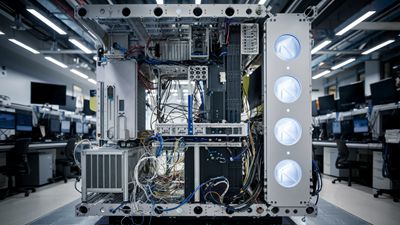AST SpaceMobile: Reaching for the Stars or Overheating in Orbit?
AST SpaceMobile, Inc. (NASDAQ: ASTS) has experienced a remarkable surge in its stock price, rising over 450% year-to-date. This report delves into the factors driving this surge, evaluates the company’s potential, and examines the risks it faces. With a focus on recent developments, financial performance, strategic partnerships, and market positioning, this report aims to provide a comprehensive analysis of AST SpaceMobile’s current status and future prospects.
Introduction
Recent Developments
Satellite Launch Preparations
One of the most significant milestones for AST SpaceMobile in 2024 is the upcoming launch of its first five BlueBird satellites, scheduled for September 12. These satellites are designed to provide nearly 100% geographical coverage of the continental United States using the 850 MHz low-band spectrum, which offers superior signal penetration. The successful deployment of these satellites is expected to mark a critical step toward the company’s goal of full commercial operations.
Technological Advancements
AST SpaceMobile has made notable technological advancements, including the completion of the AST5000 ASIC chip. This chip promises up to a tenfold improvement in satellite processing bandwidth, enhancing service quality and capacity. The company is also approximately 95% vertically integrated for the manufacturing of satellite components, allowing for better cost control and quality assurance.
Strategic Partnerships
The company has secured strategic partnerships with major telecommunications companies, including AT&T, Verizon, and Google. Verizon’s investment includes $100 million, with $65 million as commercial prepayments and $35 million in convertible notes. These partnerships are expected to enhance AST SpaceMobile’s credibility and market reach, enabling it to deliver wireless service from space through 2030.
Financial Performance
Revenue and Expenses
As of Q2 2024, AST SpaceMobile reported revenue of $900,000 against total operating expenses of $63.9 million. The company’s non-GAAP adjusted cash operating expenses increased to $34.6 million from $31.1 million in the previous quarter. Despite the significant cash burn, the company ended Q2 with $287.6 million in cash, which is sufficient to sustain its operations through the transition to commercial activity.
Capital Expenditures and Cash Position
Capital expenditures decreased to $21.2 million from $26.6 million in Q1 2024. The company has a robust financial position, with over $440 million in cash and cash equivalents as of June 30, 2024. This includes $155 million from warrant exchanges and $51.5 million in unutilized credit. AST SpaceMobile has stated that it does not plan to raise capital through underwritten public equity offerings until at least the end of 2024.
Market Capitalization and Stock Performance
AST SpaceMobile has a market capitalization of approximately $5.6 billion and reported a revenue of $0.5 million with a gross profit margin of 100% for the last twelve months as of Q1 2024. The stock has seen a one-year return of 464.72%, reflecting strong investor optimism regarding the company’s future prospects.
Market Position and Potential
Unique Value Proposition
AST SpaceMobile aims to provide space-based cellular broadband connectivity, specifically targeting areas with coverage gaps. The company’s technology allows it to connect directly to terrestrial smartphones, expanding 4G/5G coverage in hard-to-reach locations. This unique value proposition positions AST SpaceMobile favorably in a growing market.
Market Potential
Analysts from Morgan Stanley project that the space industry could be worth $1 trillion by 2040, with satellite-based broadband accounting for roughly half of that market. AST SpaceMobile’s innovative technology and strategic partnerships position it as a significant player in this burgeoning industry.
Competitive Landscape
The satellite-based broadband market is competitive, with established players like SpaceX’s Starlink posing significant competition. However, AST SpaceMobile’s focus on direct connectivity to standard mobile devices and its strategic partnerships with major telecom operators provide it with a competitive edge.
Risks and Challenges
Financial Risks
Despite its promising technology and strategic partnerships, AST SpaceMobile faces significant financial risks. The company reported a net loss of $72.6 million in Q2 2024, indicating a lack of financial viability at this stage. With approximately $285 million in cash, the company can sustain its operations for several more quarters, but it will likely need external capital to continue operations, which could dilute current investors’ stakes.
Regulatory and Operational Risks
While the company has secured initial approval from the Federal Communications Commission (FCC) for its first five satellites, additional licenses are required to fully operate its space-based services in the U.S. The complexities involved in integrating space-based systems with terrestrial networks could impact operational efficiency. Furthermore, the success of the upcoming satellite launches will be a critical indicator of the company’s technological capabilities and market readiness.
Market Competition
The competitive landscape is intense, with potential challenges from other satellite operators like Starlink. AST SpaceMobile must contend with existing mobile network operators and potential competition from other satellite communication companies. The company’s ability to differentiate itself and capture market share will be crucial to its long-term success.
Funding and Capital Sources
AST SpaceMobile’s reliance on external capital sources, such as debt or equity dilution, adds a layer of uncertainty regarding the timely deployment of its satellite constellation. While the company has secured strategic investments from major players like AT&T, Verizon, Google, and Vodafone, the need for additional funding could impact investor sentiment and stock performance.
Conclusion
AST SpaceMobile is at a critical juncture as it prepares to launch its first five BlueBird satellites and transition to commercial operations. The company’s recent stock surge reflects strong investor optimism driven by technological advancements, strategic partnerships, and a robust financial position. However, significant risks and challenges remain, including financial viability, regulatory hurdles, market competition, and funding uncertainties.
In conclusion, while AST SpaceMobile has the potential to revolutionize global connectivity and capture a significant share of the burgeoning satellite-based broadband market, it must navigate a complex landscape of financial, regulatory, and operational challenges. Investors should weigh the high-risk, high-reward nature of this investment carefully, considering both the company’s promising prospects and the substantial risks it faces.


